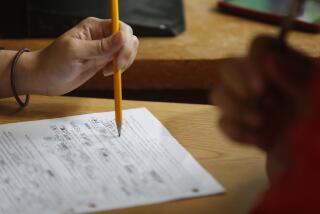2 From UCSD Plot How Brain Memorizes : Science: Decade of research produces a ‘wiring diagram’ that will aid in preventing or halting memory loss.
- Share via
Two researchers from the UC San Diego School of Medicine have identified the anatomical structures involved in memory, drawing for the first time “a wiring diagram” of how facts and events are recorded by the human brain.
In an article in today’s edition of the journal Science, researchers Larry Squire and Stuart Zola-Morgan pull together a decade’s research--much of it their own--to describe how the parts of the brain’s medial temporal lobe memory system functions to record a memory.
Knowledge of the structures involved in memory and how they function will aid researchers attempting to prevent or halt memory loss because of disease or trauma to the brain, Zola-Morgan said. Damage to the memory structure is commonly caused by lack of oxygen or blood, the researchers said.
“We now have this system identified,” he said. “We know what the components are of this memory system in the brain.”
Scientists have known for years that the brain’s memory system is lodged in the medial temporal lobe, deep within its cortex. With the aid of new technology used on monkeys, Squire and Zola-Morgan, who are also affiliated with the VA Medical Center, were able to piece together the different structures involved and how they function.
With the aid of magnetic resonance imaging equipment, the researchers were able to use electrodes to destroy specific parts of monkeys’ brains, then tested the animals for deficits to determine each structure’s function. This process of elimination testing gradually allowed them to sort out each structure’s role in memory, Zola-Morgan said.
Testing of human subjects with amnesia also helped the researchers reach their conclusions.
The pair believe that the core of the system is the hippocampus, a sausage-shaped structure about 1 3/4 inches long and a quarter of an inch in diameter. Also crucial to the memory system are the entorhinal, perirhinal and parahippocampal cortices, which surround the hippocampus and, with other parts of the brain, take part in a chain of events set off by the hippocampus that transfer perceptions into lasting memories.
Different parts of the brain are activated by various stimuli that constitute a perception--sights, sounds and touches that make up an event.
For the perception to become a long-term memory, the information must be gathered up from many brain regions and communicated to the hippocampus, where it is bound together and recorded as memory-creating structural changes in the brain at the cellular level, Squire said.
To recall the memory, a person might think of just one of the clues, stimulating the hippocampus to send instructions to the appropriate brain regions to activate all the information that constitutes the memory.
Over time, a pattern for the memory will be created in the various regions of the brain so that the memory can be called up without help from the hippocampus, the researchers hypothesize.
By enabling us to recall memories in the short-term, the hippocampus, in effect, relieves the brain of the need to make structural changes and create long-term memories of each perception, however useless or important it may be, Squire explained.
Given time, the brain selects which perceptions it wants to gradually convert into long-term memories, he said.
Squire is also using new technology that allows him to take pictures of volunteers’ brains as they perform different learning tasks. The images help him pinpoint regions of the brain involved in creating a new memory.




